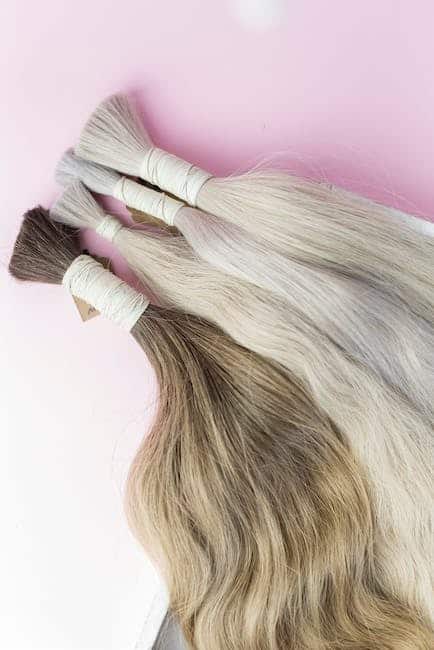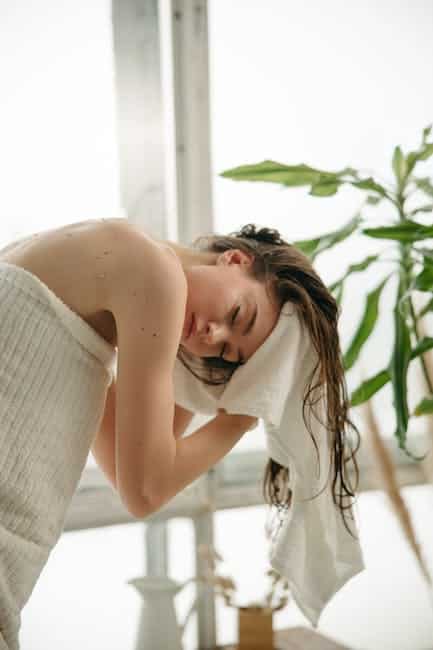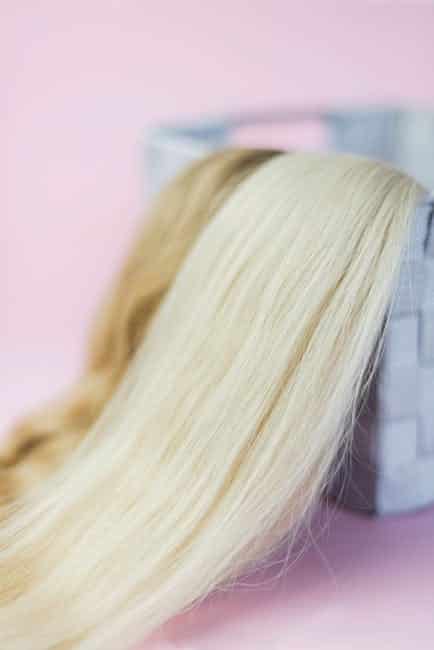Are you looking for the best hair extension method for your thin hair? You've come to the right place. I'm here to provide you with all the information you need about different methods for applying hair extensions, their pros and cons as well as some tips and tricks on how to make the most out of your hairstyle with extensions.
Choosing between glued-in extensions, clip-in extensions, sewn-in extensions and other options can be difficult if you don't know what these words even mean. In this blog post, we'll cover everything from the types of hair extensions that are available to which methods are best suited to fine hair.
We'll also discuss halo hair extensions, tape-in hair extensions, clip-in hair extensions, hand-tied wefts and more – so whether you’re trying to disguise hair loss or merely achieve a whole new look; there is something for everyone in this comprehensive guide.
What is a hair extension?
Curious about what is the best hair extensions? Let me explain! Hair extensions are a great way to add length, volume and colour to your hair. There are many different types of extensions available today, each with their own unique benefits which depend on your hair type and needs. In this post I'll explore the popular options—tape-in, fusion and clip-in extensions—so you can decide which one's best for you. Let's dive in!

Types of hair extensions available
Are you dreaming of gorgeous hair that's full of body and volume? If so, then you’ve probably considered trying out hair extensions. Hair extensions are a great option for those who want instant length and volume without having to wait months for their own hair to grow out.
But with so many different types of hair extensions on the market, it can be difficult to decide which one is the best hair extension for you. In this blog post, I’m going to discuss the various types of hair extensions available and help you determine which one offers the best option for your particular needs.
Whether you're looking to add some flair for special occasions or just wanting something more permanent, we'll look at tape-in extensions, clip-in extensions, fusion hair extensions and other methods – as well as discussing some tips on how to choose the least damaging type of extension for your own unique hair type!
Benefits and Disadvantages of Hair Extensions for Thin Hair
If you have thinner, finer hair, then adding length and volume with hair extensions can be a great way to enhance your look. But before you jump into the world of what is the best hair extension, it’s important to understand both the benefits and disadvantages that come along with using them. In this blog post, we'll cover some of the pros and cons of using extensions on thinner hair so that you can make an informed decision about which type is the best hair extension for you.
We will discuss some of the most popular types of extensions – including clip-in, temporary extensions, and hand-tied hair extensions – as well as factors such as how much damage they could cause your existing hair and how long they last. We’ll also talk about what type of hair care should be done when you’re wearing extensions and when it's best to visit a qualified hair stylist. By the end of this post, you'll have a better idea of which type of extension is best suited for those with thinner or finer hair!
Pros and cons of your options
Clip-in hair extensions are a great way to instantly add volume and length to your hair, with no commitment required. They are quick and easy to attach and can be done at home by yourself. This saves time and money as you don't need to visit a hair stylist. The downside of clip-ins is that they can start to feel heavy on thin or finer hair and may cause some unnatural looking clumps on the scalp when not applied correctly.
Temporary extensions are the perfect option for those looking for an occasional touch of glamour for special occasions or nights out. These require professional application from a qualified hairdresser but are very lightweight, so won’t drag down your natural locks. However, these extensions will only last up to a few weeks before needing to be removed, plus they can be quite expensive as you have to pay for each application.

Fusion hair extensions offer longer-lasting results than other types of extension options but require more upkeep and care in order for them to last long term. They are attached close to the scalp with adhesive bonds which mean that they lay flat against your head giving you full coverage without any visible tracks when installed correctly. On the flip side, this method requires more expertise in application so you should only use a professional hairdresser who is experienced in applying fusion extensions.
Lastly, hand-tied hair extensions are constructed using smaller strands of human or synthetic hair stitched together with a weft threading method into one continuous track. This type of extension looks very natural and is less intrusive on thinner or finer hair due to its lightweight nature – however it still requires professional application from a qualified stylist every 4-6 weeks as part of its maintenance routine.
Recommended Methods for Applying the Best Hair Extensions to Thin Hair
If you have thinner or finer hair, adding length and volume with hair extensions can be a great way to enhance your look. But before you take the plunge, it’s important to understand the recommended methods for applying extensions on thin hair so that your extensions last long term and won’t cause damage to your existing locks.
In this blog post, we'll cover some of the best techniques for applying and removing hair extensions specifically formulated for those with thinner strands. We will start by discussing the types of extension options available – including keratin bond, nano rings and micro rings – as well as how much weight each type of extension can hold in comparison to other methods. We’ll also review which type of technique is best suited for thinner strands of hair and why they are preferable over other methods.
We’ll also talk about hand-tied extensions and their unique benefits that make them an ideal choice for those with thin or fine hair. Lastly, we'll discuss any drawbacks that might come from wearing extensions in order to help you make an informed decision about whether or not this is the right option for you!
Glued-in extensions
Glued-in hair extensions are a popular choice for those looking to instantly add length and volume to their tresses. With no need for professional installation, many people choose this method as it is quick and easy to apply at home with only a few tools required.
However, before you decide on this option it’s important to understand the pros and cons of glued-in extensions as well as the best techniques for application and removal. The main benefit of glued-in hair extensions is that they can be applied in minutes with minimal effort – making them ideal for those who are time poor or lack experience with applying extensions.

Tape extensions, on the other hand, require more precision in order to have an even result. Additionally, glue based systems are often better suited for thicker strands of hair due to the thinness of the tape strips themselves. Another advantage of choosing glued-in extensions is that they last much longer than other methods – up to 12 weeks!
This makes them particularly suited to those wanting long-term results without having to worry about maintenance or frequent reapplication like some other options require. However, there are also some drawbacks associated with this type of extension system which must be considered prior to application.
Firstly, if not applied correctly they can slip out after only a few days – causing possible damage and discomfort from any adhesive stuck on the scalp!
Secondly, unlike tape or clip-ins which can be easily removed by yourself at home; glued-in extensions require a specialized removal process which should always be done by a qualified hairdresser in order to minimize tangling or breakage during the process.
Ultimately, it’s your decision what you consider to be the best hair extension, but make sure you research each one thoroughly so you make the best choice for both your hair type and lifestyle requirements!
Clip-in extensions
Clip-in extensions are one of the most popular forms of hair extensions available as they're quick and easy to apply and remove at home without the need for a professional hairdresser.
But before you make your purchase, it’s important to understand what clip-in extensions are and how to choose the right type for your hair type in order to maximize their effectiveness and longevity. Clip-in extensions come in many different forms – from individual strands to weft hair extensions which attach directly to the hair follicles with clips.
Each type has its own unique benefits so it’s important to research each option prior to making a decision on which is best suited for you. For instance, individual strands allow you greater range when styling your locks but may require more time when applying than larger set pieces such as wefts.
When selecting clip-ins, it’s important to know what size pieces will work best with your current thickness – fine or thick hair – so that they blend seamlessly and look natural. You should also consider whether the clips will be comfortable in your scalp depending on how long you plan to wear them.
Lastly, if you don’t feel confident enough applying clip-ins yourself then visiting a reputable salon is an option where professionals can help guide your choice based on personal requirements – from colour match to thickness. Consider seeking out salons that use quality Remy human hair for a more voluminous look that won't tangle or shed over time!
Sewn-in extensions
Sewn-in extensions are often chosen by those looking for a long lasting and seamless weave that can be safely worn without causing any damage to the hair follicles or scalp. But before making the decision to opt for this type of extension method, it’s important to understand its advantages and disadvantages so you can choose the best solution for your needs.

The main benefit of sewn-in extensions is that they have a very natural appearance with no risk of slipping out during styling. They also add volume and length instantly with minimal effort as compared to other styles such as clip-ins which may require more application time depending on the size of their pieces.
Additionally, sewn-ins are ideal for those wanting maximum longevity as they can stay in place (without needing reapplication) for up to 8 weeks!
However, it’s important to note that this form of hair extension comes with some drawbacks – namely the cost associated with having them professionally installed in a salon. Sewn-in extensions also require expert skill to ensure they are applied correctly and with minimal damage, so it's important you seek out a reputable salon with experience in this field.
It’s also worth noting that these types of weaves aren’t suitable for all hair types; so if you have fine or thin tresses then another form of extension may be better suited for your individual requirements.
Ultimately, sewn-in extensions are usually seen as a great way to achieve voluminous locks quickly and easily – but remember there many different ways to wear your hair! So, make sure you consider all the pros and cons prior to making your selection in order to get the best results possible!
Tips and Tricks for Making the Most Out of Your Hairstyle with Extensions
Adding hair extensions to complete your look can be a great way to boost both length and volume, giving you the opportunity to make the most out of your hairstyle. But before getting started with this transformative process, there are a few things you'll need to consider in order to ensure the best results possible.
Firstly, it's important to choose the best hair extensions for you. Clip-in pieces are considered the least damaging hair extensions, whilst wefts allow for easier application without having to commit too long time wise while sewn-in extensions offer semi-permanent options – however each come with their own individual pros and cons so make sure you research properly prior to making a selection.
As well as thinking about which type works as the best hair extension , it's also essential that you take into account both your hair type and texture.
For instance those who have fine tresses may want to opt for Remy human hair extensions which are lightweight and provide extra thickness without weighing them down too much; whereas those with coarse locks may require extra weight from thicker pieces in order to achieve maximum volume.
Finally, when selecting colour, make sure you find one that will blend perfectly with your natural hue – don’t forget that if you opt for invisible wire extensions these may require different shades depending on the depth of your colour! Also remember not all salons are equal – do some research and find an experienced technician who will provide consistent and professional results.
With the right know-how and attention, making the most out of extensions is easy! Whether they're visible or invisible is up to you – just weigh up all extension types and extension methods before making a choice about the best extensions so that you enjoy long-lasting voluminous locks!
FAQs
-
Are hair extensions reusable?
Yes, depending on the type of extension you have chosen. Clip-in and weft pieces are generally more resistant to wear and tear and can be reused multiple times as long as they’re handled with care. Sewn-in extensions can also be reused providing the same level of care is given, however will need to be reattached at the root by a professional such as those found in a salon or hair extension bar.
-
How quickly can I get hair extensions?
This depends largely on what type you choose and how much work needs to be done in order to install them. Clip-ins are usually the quickest option since they simply require clipping into place; this could take anything from 5 minutes up to an hour depending on their size. For sewn-ins or tape-ins it may take longer in order for the extension pieces to be properly attached – around 3 hours per session – but these offer a much more permanent solution that can last for several months. Clip-ins are considered by some to be the best hair extension option.
-
What are the most comfortable hair extensions?
The best hair extensions for comfort are those made from real human hair like Remy or virgin locks which feel light and natural when worn due to their soft fibres. Some synthetic options may also feel comfortable and lightweight against your scalp if manufactured correctly but tend not to move quite as naturally when styling. Depending on your individual requirements, both real and synthetic pieces offer great solutions so it’s important you consider all available options before making a selection!
-
What are the best hair extensions for beginners?
If you’re new to wearing extensions then clip-ins are often recommended as they don’t require any additional tools or expertise (apart from knowing how backcombing works) – so you can style them yourself at home without having to commit too much time or money! Clip-ins also offer maximum flexibility in terms of size and colour so it's worth shopping around until you find one that fits your personal style perfectly! Once again these are considered the best hair extension option by many.


